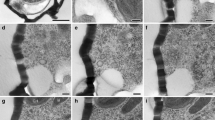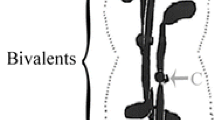Abstract
Meiotic prophase in Schizosaccharomyces pombe is characterized by striking nuclear movements and the formation of linear elements along chromosomes instead of tripartite synaptonemal complexes. We analysed the organization of nuclei and microtubules in cells of fission yeasts undergoing sexual differentiation. S. japonicus var. versatilis and S. pombe cells were studied in parallel, taking advantage of the better cytology in S. versatilis. During conjugation, microtubules were directed towards the mating projection. These microtubules seem to lead the haploid nuclei together in the zygote by interaction with the spindle pole bodies at the nuclear periphery. After karyogamy, arrays of microtubules emanating from the spindle pole body of the diploid nucleus extended to both cell poles. The same differentiated microtubule configuration was elaborated upon induction of azygotic meiosis in S. pombe. The cyclic movements of the elongated nuclei between the cell poles is reflected by a dynamic and coordinated shortening and lengthening of the two microtubule arrays. When the nucleus was at a cell end, one array was short while the other bridged the whole cell length. Experiments with inhibitors showed that microtubules are required for karyogamy and for the elongated shape and movement of nuclei during meiotic prophase. In both fission yeasts the SPBs and nucleoli are at the leading ends of the moving nuclei. Astral and cytoplasmic microtubules were also prominent during meiotic divisions and sporulation. We further show that in S. versatilis the linear elements formed during meiotic prophase are similar to those in S. pombe. Tripartite synaptonemal complexes were never detected. Taken together, these findings suggest that S. pombe and S. versatilis share basic characteristics in the organization of microtubules and the structure and behaviour of nuclei during their meiotic cell cycle. The prominent differentiations of microtubules and nuclei may be involved in the pairing, recombination, and segregation of meiotic chromosomes.
Similar content being viewed by others
References
Adachi Y, Toda T, Niwa O, Yanagida M (1986) Differential expression of essential and nonessential α-tubulin genes in Schizosaccharomyces pombe. Mol Cell Biol 6:2168–2178
Alfa CE, Hyams JS (1990) Distribution of tubulin and actin through the cell division cycle of the fission yeast Schizosaccharomyces japonicus var. versatilis. J Cell Sci 96:71–77
Ashton M-L, Moens PB (1982) Light and electron microscopy of conjugation in the yeast Schizosaccharomyces octosporus. Can J Microbiol 28:1059–1077
Bähler J, Wyler T, Loidl J, Kohli J (1993) Unusual nuclear structures in meiotic prophase of fission yeast: a cytological analysis. J Cell Biol 121:241–256
Bähler J, Hagens G, Holzinger G, Scherthan H, Heyer W-D (1994) Saccharomyces cerevisiae cells lacking the homologous pairing protein p175SEPJ arrest at pachytene during meiotic prophase. Chromosoma 103:129–141
Byers B, Goetsch L (1975) Behavior of the spindle plaques in the cell cycle and conjugation of Saccharomyces cerevisiae. J Bacteriol 124:511–523
Calleja GB, Yoo BY, Johnson BF (1977) Fusion and erosion of cell walls during conjugation in the fission yeast (Schizosaccharomyces pombe). J Cell Sci 25:139–155
Chikashige Y, Ding D-Q, Funabiki H, Haraguchi T, Mashiko S, Yanagida M, Hiraoka Y (1994) Telomere-led premeiotic chromosome movement in fission yeast. Science 164:270–273
Conti SF, Naylor HB (1960) Electron microscopy of ultrathin sections of Schizosaccharomyces octosporus. II. Morphological and cytological changes preceding ascospore formation. J Bacteriol 79:331–340
Delgado MA, Conde J (1984) Benomyl prevents nuclear fusion in Saccharomyces cerevisiae. Mol Gen Genet 193:188–189
Dresser ME, Giroux CN (1988) Meiotic chromosome behaviour in spread preparations of yeast. J Cell Biol 106:567–573
Egel R, Egel-Mitani M (1974) Premeiotic DNA synthesis in fission yeast. Exp Cell Res 88:127–134
Funabiki H, Hagan I, Uzawa S, Yanagida M (1993) Cell cycle-dependent specific positioning and clustering of centromeres and telomeres in fission yeast.J Cell Biol 121:961–976
Fussell CP (1987) The Rabl orientation: a prelude to synapsis. In: Moens P (ed) Meiosis. Academic Press, New York, pp 275–299
Gabriel M (1984) Karyokinesis and septum formation during the regeneration of incomplete cell walls in protoplasts of Schizosccharomyces japonicus var. versatilis: a time-lapse microcinematographic study. J Gen Microbiol 130:625–630
Hagan IM, Hyams JS (1988) The use of cell division cycle mutants to investigate the control of microtubule distribution in the fission yeast Schizosaccharomyces pombe. J Cell Sci 89: 343–357
Hagan IM, Riddle PN, Hyams JS (1990) Intramitotic controls in the fission yeast Schizosaccharomyces pombe: the effect of cell size on spindle length and the timing of mitotic events. J Cell Biol 110:1617–1621
Hagan I, Yanagida M (1995) The product of the spindle formation gene sadl + associates with the fission yeast spindle pole body and is essential for viability. J Cell Biol 129:1033–1047
Hamaguchi MS, Hiramoto Y (1986) Analysis of the role of astral rays in pronuclear migration in sand dollar eggs by the colcemid-UV method. Dev Growth Differ 28:143–156
Hassan L, Jones RN (1994) Long-range effects of colchicine sensitivity on meiosis in Lolium multiflorum (Italian ryegrass). Heredity 73:65–71
Hiraoka Y, Toda T, Yanagida M (1984) The nda3 gene of fission yeast encodes β-tubulin: a cold sensitive nda3 mutation reversibly blocks spindle formation and chromosome movement in mitosis. Cell 39:349–358
Hirata A, Tanaka K (1982) Nuclear behavior during conjugation and meiosis in the fission yeast Schizosaccharomyces pombe. J Gen Appl Microbiol 28:263–274
Hirata A, Shimoda C (1994) Structural modification of spindle pole bodies during meiosis II is essential for the normal formation of ascospores in Schizosaccharomyces pombe: ultrastructural analysis of spo mutants. Yeast 10:173–183
Hoheisel JD, Maier E, Mott R, McCarthy L, Grigoriev AV, Schalkwyk LC, Nizetic D, Francis F, Lehrach H (1993) High resolution cosmid and P1 maps spanning the 14 Mb genome of the fission yeast S. pombe. Cell 73:109–120
Huffaker TC, Thomas JH, Botstein D (1988) Diverse effects of β-tubulin mutations on microtubule formation and function. J Cell Biol 106:1997–2010
Hyman AA, White JG (1987) Determination of cell division axes in the early embryogenesis of C. elegans. J Cell Biol 105: 2123–2135
Kamada T, Hirai K, Fuji M (1993) The role of the cytoskeleton in the pairing and positioning of the two nuclei in the apical cell of the dikaryon of the basidiomycete Coprinus cinereus. Exp Mycol 17:338–344
Katsuta J, Hashiguchi Y, Shibaoka H (1990) The role of the cytoskeleton in positioning of the nucleus in premitotic tobacco BY-cells. J Cell Sci 95:413–422
Kleckner N, Padmore R, Bishop DK (1991) Meiotic chromosome metabolism: on eview. Cold Spring Harbor Symp Quant Biol 56:729–742
Kohli J (1994) Telomeres lead chromosome movement. Curr Biol 4:724–727
Kohli J, Bähler J (1994) Homologous recombination in fission yeast: absence of crossover interference and synaptonemal complex. Experientia 50:295–306
Kohli J, Hottinger H, Munz P, Strauss A, Thuriaux P (1977) Genetic mapping in Schizosaccharomyces pombe by mitotic and meiotic analysis and induced haploidization. Genetics 87: 471–489
Loidl J (1990) The initiation of meiotic chromosome pairing: the cytological view. Genome 33:759–778
Loidl J, Nairz K, Klein F (1991) Meiotic chromosome synapsis in a haploid yeast. Chromosoma 100:221–228
Loidl J, Klein F, Scherthan H (1994) Homologous pairing is reduced but not abolished in asynaptic mutants of yeast. J Cell Biol 125:1191–1200
Masuda H, Sevik M, Cande WZ (1992) In vitro microtubule-nucleating activity of spindle pole bodies in fission yeast Schizosaccharomyces pombe: cell cycle- dependent activation in Xenopus cell-free extracts. J Cell Biol 117:1055–1066
McCully EK, Robinow CF (1971) Mitosis in the fission yeast Schizosaccharomyces pombe: a comparative study with light and electron microscopy. J Cell Sci 9:475–507
Meluh PD, Rose MD (1990) KAR3, a kinesin-related gene required for yeast nuclear fusion. Cell 60:1029–1041
Moens PB (1994) Molecular perspectives of chromosome pairing at meiosis. Bioessays 16:101–106
Molnar M, Bähler J, Sipiczki M, Kohli J (1995) The rec8 gene of Schizosaccharomyces pombe is involved in linear element formation, chromosome pairing, and sister-chromatid cohesion during meiosis. Genetics 141:61–73
Olson LW, Edén U, Egel-Mitani M, Egel R (1978) Asynaptic meiosis in fission yeast? Hereditas 89:189–199
Palmer RE, Sullivan DS, Huffaker T, Koshland D (1992) Role of astral microtubules and actin in spindle orientation and migration in the budding yeast Saccharomyces cerevisiae. J Cell Biol 119:583–593
Parvinen M, Söderström K-O (1976) Chromosome rotation and formation of synapsis. Nature 260:534–535
Robinow CF (1977) The number of chromosomes in Schizosaccharomyces pombe: light microscopy of stained preparations. Genetics 87:491–497
Robinow CF, Hyams JS (1989) General cytology of fission yeast. In: Nasim A, Young P, Johnson BF (eds) Molecular biology of the fission yeast. Academic Press, San Diego, pp 273–330
Roeder GS (1990) Chromosome synapsis and genetic recombination: their roles in meiotic chromosome segregation. Trends Genet 6:385–389
Rouvière C, Houliston E, Carré D, Chang P, Sardet C (1994) Characteristics of pronuclear migration in Beroe ovata. Cell Motil Cytoskeleton 29:301–311
Schatten G (1982) Motility during fertilization. Int Rev Cytol 79: 59–163
Scherthan H, Bähler J, Kohli J (1994) Dynamics of chromosome organization and pairing during meiotic prophase in fission yeast. J Cell Biol 127:273–285
Scherthan H, Loidl T, Schuster T, Schweizer D (1992) Meiotic chromosome condensation and pairing in Saccharomyces cerevisiae studied by chromosome painting. Chromosoma 101: 590–595
Sipiczki M (1989) Taxonomy and phylogenesis. In: Nasim A, Young P, Johnson BF (eds) Molecular biology of the fission yeast. Academic Press, San Diego, pp 431–452
Snell V, Nurse P (1993) Investigations into the control of cell form and polarity: the use of morphological mutants in fission yeast. Development [Suppl]:289–299
Snyder M (1994) The spindle pole body of yeast. Chromosoma 103:369–380
Sullivan DS, Huffaker TC (1992) Astral microtubules are not required for anaphase B in Saccharomyces cerevisiae. J Cell Biol 119:379–388
Tanaka K, Hirata A (1982) Ascospore development in the fission yeast Schizosaccharomyces pombe and S. japonicus. J Cell Sci 56:263–279
Toda T, Umesono K, Hirata A, Yanagida M (1983) Cold-sensitive nuclear division arrest mutants of the fission yeast Schizosaccharomyces pombe. J Mol Biol 168:251–270
Umesono K, Toda T, Hayashi S, Yanagida M (1983) Two cell-division cycle genes, nda2 and nda3 of the fission yeast Schizosaccharomyces pombe control microtubular organization and sensitivity to anti-mitotic benzimidazole compounds. J Mol Biol 168:271–284
Weiner BM, Kleckner N (1994) Chromosome pairing via multiple interstitial interactions before and during meiosis in yeast. Cell 77:977–991
Widra A, Delamater DE (1955) The cytology of meiosis in Schizosaccharomyces octosporus. Am J Bot 42:423–435
Woods A, Sherwin T, Sasse R, McRae TH, Baines AJ, Gull K (1989) Definition of individual components within the cytoskeleton of Trypanosoma brucei by a library of monoclonal antibodies. J Cell Sci 93:491–500
Xiang X, Beckwith SM, Morris NR (1994) Cytoplasmic dynein is involved in nuclear migration in Aspergillus nidulans. Proc Natl Acad Sci USA 91:2100–2104
Author information
Authors and Affiliations
Rights and permissions
About this article
Cite this article
Svoboda, A., Bähler, J. & Kohli, J. Microtubule-driven nuclear movements and linear elements as meiosis-specific characteristics of the fission yeasts Schizosaccharomyces versatilis and Schizosaccharomyces pombe . Chromosoma 104, 203–214 (1995). https://doi.org/10.1007/BF00352185
Received:
Accepted:
Issue Date:
DOI: https://doi.org/10.1007/BF00352185




